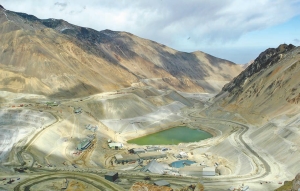A massive earthquake that struck central Chile, 115 km northeast of Concepcion and about 325 km southwest of Santiago, on Feb. 27 has claimed the lives of at least 700 people and destroyed more than half a million homes.
The quake registered a magnitude of 8.8, significantly higher than the 7.0-magnitude quake that devastated Haiti in January, but less than the 9.5-magnitude earthquake that rocked Chile in May 1960.
The 1960 quake, the largest in more than 200 years, was about 230 km south of the source region of the latest Chilean quake, and claimed the lives of 1,600 people in Chile and another 200 in Japan, Hawaii and the Philippines, according to the U.S. Geological Survey’s website.
The latest quake occurred at the boundary of the Nazca and South American tectonic plates, with the Nazca plate moving down and landward below the South American plate.
With Chile ranking as the world’s largest copper producer, concerns about supply disruptions pushed up copper prices about 5.6% in early trading on March 1 — their highest level in five weeks — before easing.
The earthquake appears to have had limited impact on copper production, however, as the key mining operations are in the northern part of the country. The biggest threat to production now appears to be the consistency of the power supply and the possibility of more blackouts.
State energy firm ENAP closed down its 116,000-barrel-per-day Bio Bio refinery, just north of the city of Concepcion, and its 100,000-barrel-per- day Aconcagua refinery near Santiago, due to damages.
“While it is still extremely early in the process, it appears that most of the mines have emerged from the earthquake structurally unscathed, but there have been some power issues which may have briefly impacted production over the weekend,” Dahlman Rose & Co. wrote to clients in its March 1 research note. “It is still possible that damage to rail and port facilities may impact the flow of copper over the near-term, but to date, no evidence has emerged that will require a meaningful change in our supply/demand model.”
Most mining companies reported on March 1 that their mining operations are back on track.
Antofagasta’s (ANTO-L) Los Pelambres mine, 200 km northeast of Santiago, resumed operations on Feb. 28, after the quake temporarily disrupted its power supply. Freeport-McMoRan Copper & Gold (FCX-N) said it was resuming production at its Candelaria mine, but that power supply problems persisted.
State-owned miner Codelco suspended operations on Feb. 27 at its El Teniente mine, 75 km southwest of Santiago, and at its Andina mine, 50 km northeast of Santiago. Operations resumed on Feb. 28 at El Teniente and are believed to have come back online at Andina by the end of March 2, Reuters news agency reported.
Anglo American (AAUKY-O, AAL-L), meanwhile, reported that four of its operations had been affected including its Chagres copper smelter and its Mantoverde mine. It halted production at its Los Bronces copper mine, 65 km northeast of Santiago, and at its El Soldado mine, 132 km north of Santiago, due to cuts to energy supply. Production was later resumed.
Amerigo Resources (ARG-T) reported that the quake occurred about 200 km away from its MVC plant in Rancagua. Its MVC operation produces copper and molybdenum.
On Feb. 27, both Xstrata (XTA-L) and BHP Billiton (BHP-N) reported that their operations were running normally.
Mines in the far north of Chile, including the Escondida and Chuquicamata mines, were unaffected and were also operating normally.
Smaller mines also reported limited disruption. Breakwater Resources (BWR-T) said that infrastructure had not been damaged at its Toqui mine, about 1,000 km south of Concepcion, while Yamana Gold (YRI-T, AUY-N, YAU-L) said its El Penon operations in northern Chile “were not meaningfully impacted and have resumed.”
Teck Resources (TCK. B-T, TCKN) TCKN) said the quake had not impacted its Andacollo and Quebrada mines, although they could still be hit by power supply problems.
Apart from the copper producers, Sociedad Quimica y Minera de Chile (SQM-N), which produces specialty plant nutrients, iodine and lithium, noted that all of its production centres, including port operations at Tocopilla, have not suffered any damage. The quake was about 1,000 km south of its operations in Chile.
Specialty chemical producer Rockwood Holdings (ROC-N) also reported no damage in the quake. Rockwood produces lithium carbonate and lithium compounds at sites in the Salar de Atacama and La Negra in Chile, about 1,450 km north of the epicentre.
Finning International (FTTT), FTTT), the world’s largest Caterpillar equipment dealer, reported that the heaviest damage was to its corporate head office in Santiago, but that all of its information systems were fully operational and that the company had relocated employees to alternative offices within Santiago.


Be the first to comment on "Chilean Mines Mostly Unscathed"